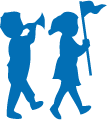Classes and Enrollment
We adjust our class offerings each year to suit the needs of our families.
Morning classes run for three hours (9:00am – 12:00pm).
Class size is typically 10 – 15.
Three-year-olds come to classes two or three days a week
Four-year-olds attend three or four days.
Field trips throughout the year are included. Afternoon Enrichment optionally continues your child’s learning into the afternoon. Summer workshops are available after the school year ends.
Tuition is surprisingly competitive, with payment options and a family discount.
2019–2020 Class Days
Four-Day 4's: Monday–Thursday
Three-Day 4's: Monday, Tuesday, & Thursday
Three-Day 3's: Tuesday, Wednesday, & Thursday
Two-Day 3's: Tuesday & Thursday
Our Approach to Classroom Education
Nutfield has a strong commitment to developing the whole child; the social, emotional, physical, creative, and intellectual aspects.
It has been found that young children need to be engaged in experiences that make academic content meaningful and that build on prior learning. Children need opportunities to explore deeply and attend in great detail to subjects of interest to them (whether the subject is bugs, shadows, trains, or floating and sinking). Implementing the curriculum becomes creating opportunities for the children to learn skills in context while making sure the activities are challenging and changing. To this end, the three- and four-year-old curriculums focus primarily on the following skills while integrating language arts, social studies, science, and math concepts:
cognitive skills
social and emotional growth
language and listening skills
small and large muscle development
developing creativity
Every day in class, each child has the opportunity to develop cognitive, social, and language skills. Children interact with other children in a one-on-one situation (choice) and in a larger group situation (circle). Children work in structured (circle, gym, and music) and unstructured (choice, outside) environments. They also have opportunities to take turns, share, problem solve, and cooperate. These experiences allow children to develop consideration of others and practice in controlling their emotions.
The three- and four-year-old classes are very language rich. The children hear and use language throughout the day; as their language develops so to does their ability to think, reason, and problem solve. The teachers talk to the children, sing with the class, and do chants and poems in addition to daily reading. One of the most crucial factors for social and cognitive development is adult responsiveness to what a child says. Back and forth exchanges are how children learn the interactive game that is conversation. Their ability to participate in conversation is crucial for future social and academic success.
Another important aspect of language is the ability to listen. The following listening skills are modeled and encouraged in the three- and four- year-old preschool classes.
establishing and maintaining eye contact with the person talking
comprehending what is being said
following directions
discriminating sounds
The development of small muscles is crucial for tracing, cutting, writing and many self-help skills. Play dough, clay, legos, and other building materials are available to the children daily to help strengthen these muscles. Large muscle skills like running, hopping, and skipping are developed in gym and on the playground. Again being in a group situation allows the children to have these skills modeled for them by peers as well as teachers.
The curriculum takes advantage of the changing seasons to provide a natural platform for teaching science and social studies concepts. Teachers work with the children to monitor the weather and its changes, how people, animals, and plants react to the weather, and how they prepare and change for the seasons. Observing, classifying, and predicting are all skills that come with these studies, all of which require language and a more sophisticated vocabulary.
Math concepts are also incorporated into the daily activities. The group discusses how many children are in school today? How many are missing? Choice time often includes board games that give the children practice moving a game piece the correct number of spaces. Teachers use puzzles that deal with number concepts. Patterning helps make children aware of the natural patterns that occur in nature and math. Shapes all around us reinforce those concepts. By using day-to-day events, the teaching of these concepts becomes very meaningful to children, allowing them to embrace these skills and apply them to other areas of their life.
What we strive for in our pre-school classes is a busy place with a variety of opportunities for children to practice and develop all of the skills necessary for future learning.



